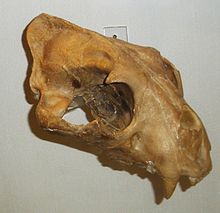Panthera onca augusta
| Panthera onca augusta Temporal range:
| |
|---|---|

| |
| Scientific classification | |
| Domain: | Eukaryota |
| Kingdom: | Animalia |
| Phylum: | Chordata |
| Class: | Mammalia |
| Order: | Carnivora |
| Suborder: | Feliformia |
| Family: | Felidae |
| Subfamily: | Pantherinae |
| Genus: | Panthera |
| Species: | |
| Subspecies: | †P. o. augusta
|
| Trinomial name | |
| †Panthera onca augusta (Leidy, 1872)
| |
| Synonyms | |
| |

Panthera onca augusta is an
History and distribution
Although

Later in 1919, Oliver Perry Hay described a left canine from Vero, Florida that he named Felis veronis, though it is now seen as a synonym of P. onca augusta.[4] In 1929, George Simpson referred several teeth from Seminole Field, Florida to F. veronis and the same year a right mandible and several teeth from Melbourne, Florida were collected by Dr. J. W. Gidley. All material found has been referred to P. onca augusta, the mandible notably was the first complete one found of the taxon. Yet another discovery came in 1938, with the discovery of 2 fragmentary postcranial skeletons of P. onca augusta in Cumberland Cave, Maryland intermingled with that of a puma.
The most productive discoveries outside of California came in 1939 and 1944, with the discoveries of footprints and several fossils in Craighead Caverns, Tennessee during the former year.[5][4] 1944 saw the collection of 2, well preserved skeletons in Salt River Cave, also in Tennessee, that included 2 partial skulls and many axial elements that clearly demonstrated the subspecies’ clear differences with other taxa.[4] Many more fossils were later collected by the American Museum of Natural History at Craighead Caverns, including several mandibles and partial craniums.[5]
Additional P. onca augusta fossils have been found in Oregon[6] and most notably, the La Brea Tar Pits of California. P. onca augusta is most frequently found in Florida’s localities, as there are many fossil-bearing sites from the Pleistocene throughout Florida.[4][5] In 2021, a partial mandible was referred to P. onca augusta from Chapala, Mexico, extending the range south to southwestern Mexico.[7]
See also
References
- ^ Panthera onca augusta in the Paleobiology Database
- ISSN 2358-2731.
- S2CID 160927286.
- ^ .
- ^ )
- ^ Richard L. Hill (2006). "Ice-age jaguar among fossil finds". The Oregonian.
- S2CID 210909875.
